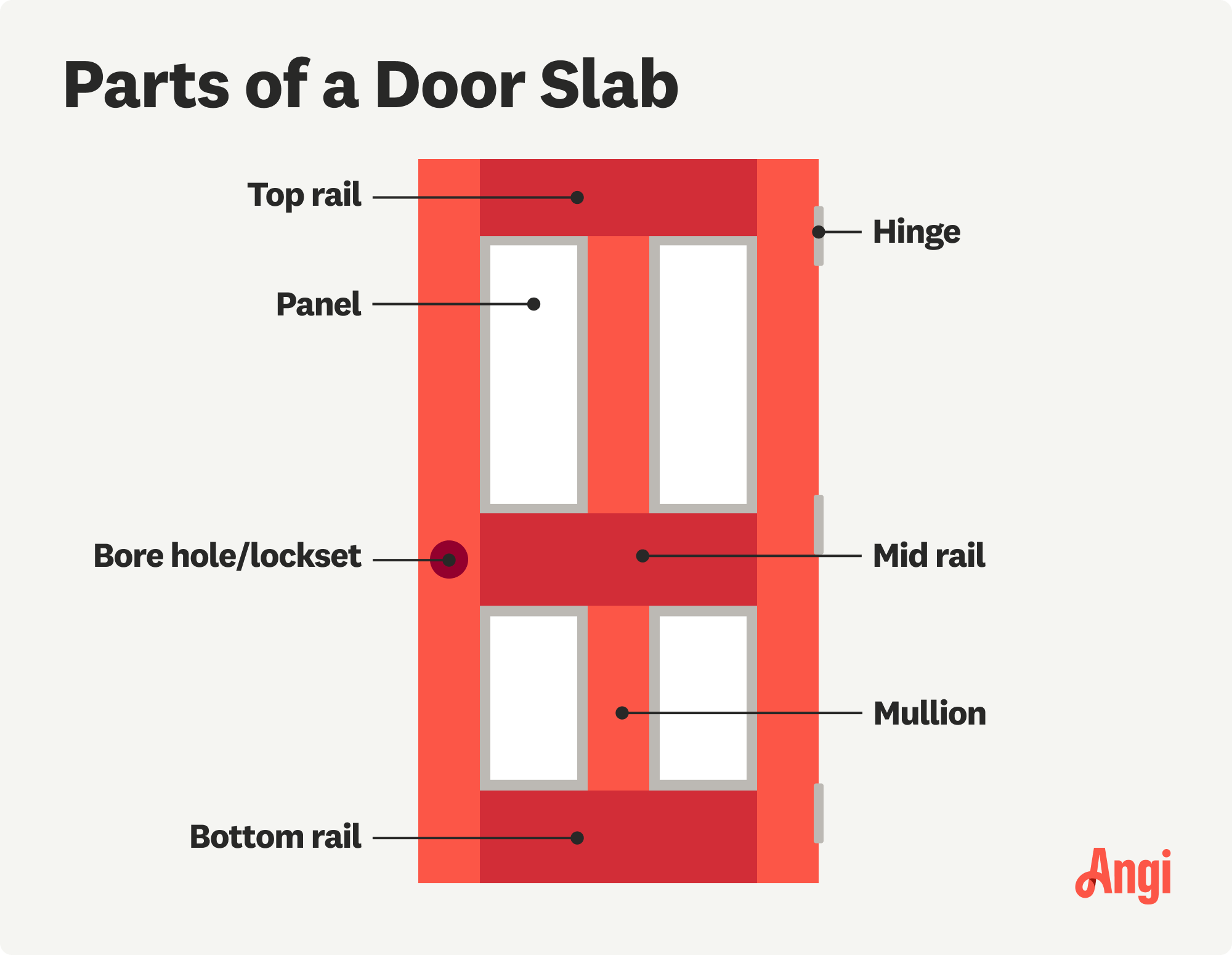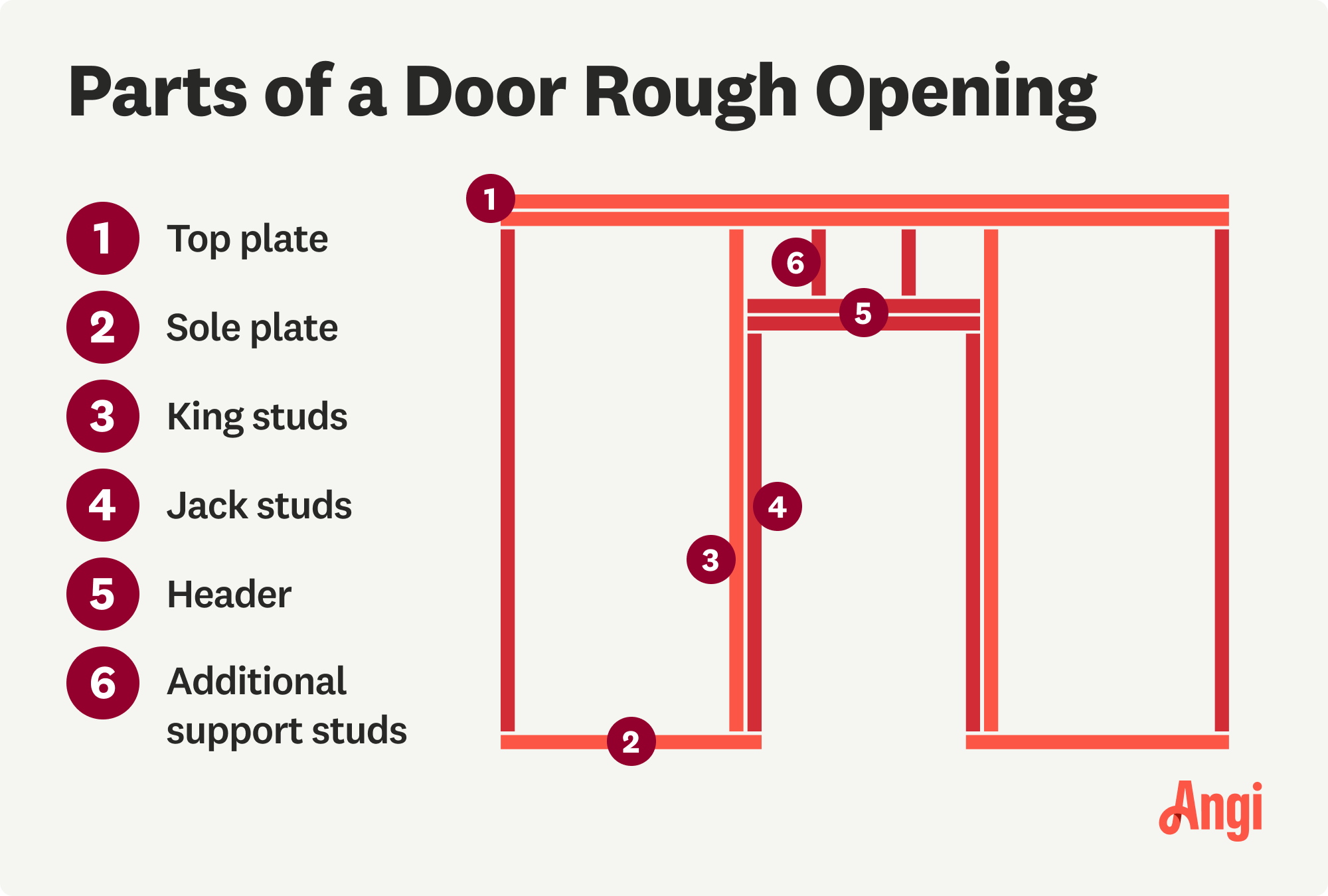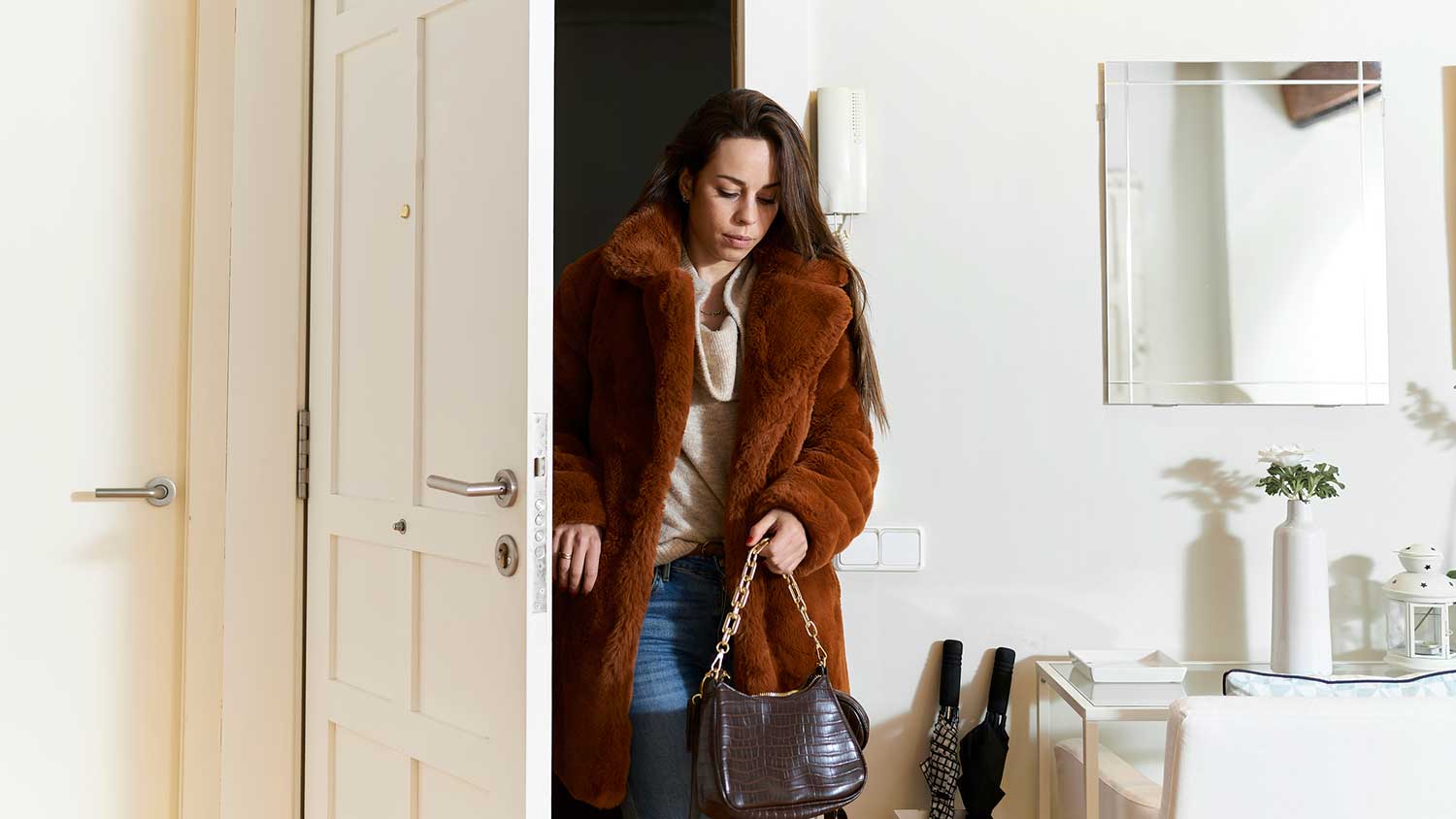All the Parts of a Door: The Homeowner’s Guide
Get your foot in the door by knowing these terms


A door includes the slab, frame, and rough opening studs.
The parts of a door determine its style, function, and cost.
There are variations between exterior and interior doors and their framing.
It's best to hire a professional to install a door from scratch for proper function. As an active and curious homeowner, understanding the parts of a door can get you out of a lot of jambs—ahem, jams. Whether you're learning how to build a door from scratch, researching door repair costs, or getting ready for new home construction, you'll need to know how each part of the door contributes to the whole. Let's fling the door wide open on all the terminology you need to know.
Main Parts of a Door

We'll begin as zoomed out as possible. Similar to any structure, it's best to talk about the overall terms related to door anatomy and then break down individual parts of each section. Here's what to know.
Door Slab
The door slab—or door panel—is the main rectangle that swings back and forth. The material and style of your door slab have a large say in your door installation costs. Exterior doors are often more solid and weatherproofed, while interior doors are lighter and occasionally hollow. They will also either come pre-hung or as a solid slab.
Door slabs may include windows, locksets, hinges, mullions, and a variety of specialty parts. We'll dive into the parts of the door slab later.
Door Frame
The door frame connects your door panel to the structure of your home. Door frames break down to the door jamb, the sill, the threshold, weatherstripping, stops, and strike plate hardware. Surrounding the door frame are the casing and the brickmold, which support the frame on the inside and outside of the home. We'll break down all of these below.
Rough Opening
Just outside the door frame, the rough opening of your wall refers to the cut that makes way for the whole installation. If you're starting from scratch, you'll need to know the supporting parts of the rough opening. These include the top and sole plates, the king and jack studs, additional support studs, and the header. More on these in a minute.
Parts of a Door Slab

Time to take a closer look at the parts of the door slab. In most cases, you will not need to build the slab itself, but knowing its parts can help you align it correctly and get to know available styles.
Stiles and Rails
On a basic level, stiles are the external vertical sections of a door panel and rails are the external horizontal ones. When broken down further, you'll find a top and a bottom rail as well as a hinge stile and a lock stile. As the names suggest, the hinge style contains the hinge hardware and vice versa.
Mullions and Midrails
Set inside the stiles and rails, you'll find the mullions—or mulls—that make up the vertical sections in the center of a door. The midrail—or lock rail—crosses the middle of the door horizontally, connecting the hinge and lock style.
Panels
The pieces set within all of the framing of the door panel—everything listed above—are called panels. In some cases, door panels are swapped out for windows, lighting, or decorative accents.
Bore Hole and Lockset
Depending on the placement and type of door you choose, there will be a bore hole for either a knob or a lockset. The types of locksets include basic knob locks, hand levers, and deadbolts. Door knob varieties also vary, ranging from dummy door knobs for decorative purposes and knobs with a keyhole.
Hinges
Hinges connect one side of the door panel to the frame so that the door swings open and closed. You can choose from several types of hinges, including ball-bearing hinges, butt hinges—the most common type—spring-loaded hinges, and more. These hinges determine whether the door is self-closing and whether it swings in one or both directions.
Specialty Parts
Door styles come in countless shapes, sizes, and functions, so you'll also find these terms incorporated into door anatomy:
Kick plate: Door kick plates protect the base of a door, particularly on the outside of an exterior door. Made of metal, plastic, or vinyl, the thin panel covers a rectangle of space on the base of the door.
Transom: Transoms are a line of individual windows that sit above a door, framed individually and set within the rough opening of the wall.
Astragal: The astragal seals the space between two doors, typically two sliding or French doors.
Sidelights: Many exterior doors have narrow panels or windows on either side of the door to extend the full installation. These are known as sidelights.
Parts of a Door Frame

What about the door anatomy surrounding the door panel? If you're not impressed by the number of new words on your vocab list yet, get ready. Next, we’re covering door frame parts. Thankfully, there will not be a quiz.
Door Jamb
Even though the terms get tossed around interchangeably, a door jamb and door frame are not the same thing. The door jamb includes the two vertical and one horizontal piece that immediately frames the door slab. The door jamb includes a hinge jamb, a latch jamb, and a head jamb—each sitting where their name implies.
Sill and Threshold
Door sills and thresholds sit along the floor and the base of the door's opening. A sill attaches directly to the rough opening of the floor for an exterior door. A threshold goes over the top of the sill to both protect its structure and make the transition look more stylish. Exterior sills and thresholds typically slant outwards to prevent water from coming inside. On an interior door, you will often only see a threshold between two rooms.
Stop
Also known as rabbets, stops are pieces of material that keep a door from swinging too far. The placement of the rabbet determines the style and function of the door. Some doors sit flush with the opening while others have a space between the frame and the slab, for example.
Weather Stripping
Door anatomy includes several areas of weather stripping depending on the door's placement around and outside your home. Exterior doors include weather stripping around the entirety of the jamb. You will also find a door sweep—or weather stripping along the bottom of the door slab.
Casing and Brickmold
The panels of wood, metal, or vinyl that cover the gap between the door frame and rough openings are known as the casing or brick molding (also known as brickmould). Casing refers to the frame around the interior of the door and often matches the interior style of the door. Brick molding, on the other hand, refers to the frame on the outside of the door. Despite its name, brick molding comes in a range of materials, often ones strong enough to seal and weatherproof the gap.
Strike Plate
Last but not least, your door frame will include a matching strike plate to line up with the door panel's lockset and knob. A metal strike plate increases the strength of the lock and adds an ornamental touch to the opening.
Parts of a Rough Opening

If you're installing a new door to a wall or observing the new construction of a home, you'll get a view into the rough opening of your door. As we mentioned earlier, a series of studs offer the necessary support to the wall so that your door melds with the structure of your home.
Top and Sole Plates
The top and sole plates sit at the top and bottom of the entire rough-opening door structure. The vertical studs of your wall and door attach to these two plates or the 2-foot by 4-foot board.
King and Jack Studs
Studs are the vertical support that carry the load of your ceiling. King studs run the length between the floor and ceiling while also supporting the sides of Jack studs. Jack studs run the length of your door and stop at the header.
Header
The header is the 2-foot by 4-foot board that frames the top of a door's rough opening. In some cases, the header and the head jamb are the same, but it depends on the structure of the rough opening. The header attaches to the king and jack studs that run vertically on either side.
Additional Support Studs
How about that space between the header, the ceiling, and the top of the jack studs? These additional support studs are the shorter 2-foot by 4-foot boards that vertically support the space above the door and under the ceiling.
Lockset Parts: Additional Door Parts
The lockset is an essential part of any door—especially exterior doors. The hardware makes it possible to open, close, and lock the door. While most locksets are similar, the specific parts depend on the type you choose and the door you install it on.
Door Handle
Door handles help you open and close doors. They’re mounted on the face of the door and connect to the latch mechanism. Entry handles include a key cylinder on the exterior and a lock mechanism on the interior. Bedroom and bathroom handles have a lock button on one side but may not have a key cylinder.
Door handles on interior doors with no locking mechanisms are called passage handles. Passage handles are best for doors to rooms and spaces that don’t require privacy, like closets, living rooms, and kitchens.
Door handles come in a lever or grip style, depending on your functional and aesthetic preferences. Lever handles mount horizontally, swing up and down, and are more accessible for people of all ages and those with disabilities. Grip-style handles mount vertically and include an opening mechanism that you press with your thumb while gripping a pull bar.
Door Knob
Door knobs are rounded handles that open with a twisting motion. Most have an internal spindle that passes through the door and connects the knobs on both sides. They’re less accessible than lever handles but are common on traditional and decorative doors. They may or may not have locking mechanisms.
Latch
A door latch is a small metal piece that inserts into a door frame and keeps the door securely closed. When you turn the knob or handle, the latch retracts, and the door opens. Spring-loaded latches automatically retract when you apply pressure, and dead-latching systems have an additional mechanism that locks the latch to prevent forced entry.
Deadbolt
Deadbolts add extra security to standard door latches. They have a solid metal bolt that extends into the door jamb or strike plate, making them harder to force open than spring mechanisms. This feature requires manual locking and unlocking with a key or thumb turn.
You can buy single-cylinder deadbolts with a keyhole on the outside and a thumb turn on the inside or double-cylinder deadbolts with a keyhole on both sides.
Thumb Turn
Thumb turns are small levers inside the door that allow users to manually unlock or lock deadbolts without a key, letting you quickly open the door from the inside. These are also a safety feature, as you can open the door without wrestling with a key. In some places, home safety codes require thumb turns on the interior side of all exterior doors.
Mortise Plates
Also called strike plates, mortise plates are the metal plates inside door jambs where the door latch or deadbolt extends into the door frame. They reinforce the area around the latch or deadbolt, providing additional strength and security.
Escutcheon
Escutcheons are decorative plates surrounding keyholes and lock cylinders. They protect the area around the keyhole from damage and prevent tampering with the lock mechanism. Some offer high-security protection against lock drilling or prying. You can buy escutcheons in various styles and finishes to complement your door hardware and home design.
How to Maintain the Different Parts of a Door
Proper maintenance can significantly increase your door’s life expectancy, ensuring security, improving insulation, and protecting your privacy at home. Fortunately, you can take care of most parts of a door yourself.
Because of the rotary motion, most parts of your door need to be cleaned and lubricated regularly to ensure proper opening and closing. For example, you should lubricate your door hinges with a silicone or lithium-based lubricant every 6 to 12 months. Similar solutions can be used to lubricate handles and levers as well. Avoid using petroleum-based lubricants (such as the notorious WD-40) because they will attract more dust and grime over time and cause more damage to your door parts. The up-front efficiency these lubricants provide can hardly justify the long-term damage they accumulate.
Other parts of the door, such as the weather strip, stopper, and windstopper, require seasonal replacement as wear and tear build up. You should also check your door frames and castings for any signs of distortion or bending, which happens over time, particularly in older homes, due to settlement.
Repairing vs. Replacing Different Door Parts
Some door parts can be easily replaced by yourself. These include door knobs or door levers, stoppers and weather stripping. If you notice minor damages on a wooden or vinyl door, you can also paint over or repair them without involving a pro.
However, if you ever need to repair or replace a glass panel on the door, address major damages, or look into structural issues around the frame, we recommend you hire a pro. On average, front door replacements cost $650 to $3,700, whereas interior door replacements may only cost a few hundred dollars.
DIY vs. Hiring a Pro
If your project involves completely removing the door panel, it’s best to leave the job to a professional door repair company. Doors can be heavy, especially if you use high-quality wooden doors or large glass doors. Improper handling can cause bodily injury or cause more damage to your door than repairing what went wrong.
Most door repair companies charge $30 to $90 per hour for labor before factoring in the cost of materials. Shop around to make sure you get the best deal from a trustworthy contractor. You can also describe to them the problems you are having with your doors, as sometimes they might walk you through what to do if it is a minor problem that can be addressed by yourself.





- 7 Common Door Problems and What Causes Them
- How to Fix a Door That Sticks: 5 Different Methods
- 8 Common Reasons Your Door Won’t Open (and How to Fix It)
- What Is a Door Jamb and How Does It Differ From the Frame?
- 5 Ways To Make Your Front Door Energy Efficient
- Garage Door Framing Diagram: Know the Measurements, Parts, and More
- How to Fortify Your Exterior Doors Against Forced Entries
- How to Secure a Door Without a Lock While You Wait for a Locksmith
- 9 Tips to Make Installing a Pocket Door in Your Home Easy
- Exploring the Different Parts of a Storm Door and Their Functions










